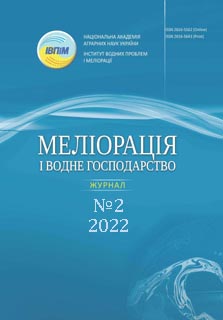THERMODYNAMIC ASPECTS OF THE GEOSYSTEM FUNCTION OF THE PEDOSPHERE
Abstract
Modern unceasing processes of dehumification and degradation of arable soils require the search for new non-traditional approaches to solving this global environmental problem, which determines the relevance of the research. After all, plowing significantly disrupts the thermodynamic interaction of the soil with environmental factors. The purpose of the publication is to consider the regularities of the evolution of the properties of the pedosphere from a geosystem perspective, to define the concept of geomembrane properties, and to reveal the mechanism of regulating the thermodynamic interaction of the soil with the environment based on the concept of its homeostasis, which will allow a more reasonable explanation and forecast of modern evolutionary changes in the properties of soils and soil cover from a higher perspective organizational level of the geosystem. The main tasks are defined as: the development of a methodology for studies of the thermodynamic interaction of soil with climatic factors, the creation of tools for monitoring the course of thermodynamically unbalanced processes in the soil environment, and their approbation in the Forest-Steppe zone of Ukraine. It is proposed to consider the soil as a dissipative thermodynamic non-equilibrium system that is constantly in the process of self-stabilization and self-organization due to interaction with climatic factors of the environment. Therefore, soil homeostasis means the presence of subordinate energy-consuming processes of a certain intensity, which form the structure of the thermodynamic system of the soil, as the structure of its pore space. It was determined that the general direction of the development of the pedosphere, as an element of the Earth's lithospheric shell, is the densification of the parent rock with the formation of structural macroporosity of the soil and the development of heterogeneity. It is shown in the example of Ukraine, that the geomembrane properties of soils have a zonal nature and are aimed at limiting the power of the zone of active energy-mass exchange.
The concept of the dynamics of geomembrane properties of the pedosphere, as a manifestation of a higher hierarchical level of geosystem organization, is proposed to be used to solve purely applied issues, such as assessing the impact of climate change, humus formation, and modern dynamics of soil fertility, increasing the sustainability and ecological safety of soil use.
References
2. Shevchenko, O.L., Bublias, V.M., & Kolomiiets S.S. (2014). Osnovy perenesennia volohy v zoni aeratsii [Basics of moisture transfer in the aeration zone]: navchalnyi posibnyk. Kyiv : Vydavnycho-polihrafichnyi tsentr «Kyivskyi universytet». [in Ukrainian].
3. Volobuev, V.R., Ponomarev, D.H., & Mykhailov, F.D. (1980). Sviaz mezhdu termodynamycheskymy funktsyiamy pochv, ih myneralogicheskym sostavom y fyltratsyonnoi sposobnostiu [Relationship between the thermodynamic functions of soils, their mineralogical composition and filtration capacity]. Pochvovedenye, 102-105. [in Russian].
4. Pryhozhyn, Y.R. (1980). Vremya, struktura y fluktuatsyya [Time, structure and fluctuation] : Nobelevskaya lektsyya po khymyy 1977 hoda. Uspekhy fyzycheskykh nauk. [in Ukrainian].
5. Khaken, H. (1985). Synerhetyka: yerarkhyya neustoychyvostey v samoorhanyzuyushchykhsya systemakh y ustroystvakh [Synergetics: hierarchy of instabilities in self-organizing systems and devices]. Moskva: Myr [in Russian].
6. Druzhynyn, D.L., & Vanyarkho, V.H. (1989). Synerhetyka y metodolohyya systemnykh yssledovanyy. Systemnye yssledovanyya. [Synergetics and methodology of system research. System Research]. Metodolohycheskye problemy. Ezhehodnyk. Moskva: Nauka [in Russian].
7. Kolomiyets', S.S. (2021). Termodynamichna systema gruntu, yoho homeostaz i virohidnyy mekhanizm utvorennya struktury [Thermodynamic system of the soil, its homeostasis and probable mechanism of structure formation]. Visnyk ahrarnoyi nauky, 3, 14-22. [in Ukrainian].
8. M.K. Shykuly (Ed.). (1998). Vidtvorennya rodyuchosti gruntiv u gruntozakhysnomu zemlerobstvi [Reproduction of soil fertility in soil conservation agriculture]. Naukova monohrafiya.. Kyyiv: PF «Oranta». [in Ukrainian].
9. Yatsyk, M.V., & Kolomiyets', S.S. (2009). Sposib vyznachennya struktury porovoho prostoru gruntiv (dyspersnykh seredovyshch) [The method of determining the structure of the pore space of soils (dispersed media)]. Patent of Ukraine. № 45287. [in Ukrainian].
10. Romashchenko, M.I., Kolomiyets', S.S., & Bilobrova, A.S. (2019). Systema laboratornoho diahnostuvannya vodno-fizychnykh vlastyvostey gruntiv [System of laboratory diagnosis of water-physical properties of soils]. Melioratsiya i vodne hospodarstvo, 2, 199-208. [in Ukrainian].
11. Kolomiyets', S.S. (1999). Ekolohichna kharakterystyka gruntu [Ecological characteristics of the soil]. Visnyk ahrarnoyi nauky, 12, 9-13. [in Ukrainian].
12. Yatsyk, M.V., Kolomiyets', S.S, Koval'chuk, V.P., & Puzhay, O.M. (2005). Gruntovo-hidrofizychne zabezpechennya matematychnoho modelyuvannya vodnoho rezhymu meliorovanykh zemel' [Soil-hydrophysical support for mathematical modeling of the water regime of reclaimed lands]. Melioratsiya i vodne hospodarstvo,. 92, 65-74. [in Ukrainian].
13. Kolomiyets', S.S. (2013). Prostorova otsinka ryzyku zabrudnennia biohennymy elementamy gruntovykh vod ahrolandshaftiv [Spatial assessment of the risk of soil water contamination by biogenic elements of agricultural landscapes]. Ahroekolohichnyi zhurnal, 35-40. [in Ukrainian].
14. Hlubokoe rykhlenye tiazhelykh myneral’nykh pochv [Deep loosening of heavy mineral soils]. Tezysy dokladov Vsesoiuznoho semynara. Mynsk, 1-50. [in Russian].
15. Ysachenko, A.H. (1980). Optymyzatsyya pryrodnoy sredy (heohrafycheskyy aspekt) [Optimization of the natural environment (geographical aspect).]. Moskva : Mysl' [in Russian].


